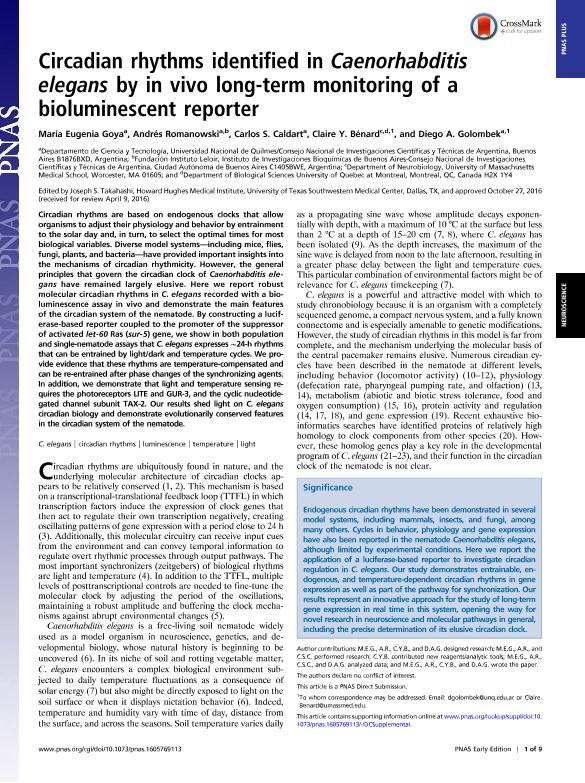Mostrar el registro sencillo del ítem
dc.contributor.author
Goya, María Eugenia

dc.contributor.author
Romanowski, Andrés

dc.contributor.author
Caldart Valle, Carlos Sebastian

dc.contributor.author
Bénard, Claire Y.
dc.contributor.author
Golombek, Diego Andrés

dc.date.available
2018-05-31T20:13:20Z
dc.date.issued
2016-11
dc.identifier.citation
Goya, María Eugenia; Romanowski, Andrés; Caldart Valle, Carlos Sebastian; Bénard, Claire Y.; Golombek, Diego Andrés; Circadian rhythms identified in Caenorhabditis elegans by in vivo long-term monitoring of a bioluminescent reporter; National Academy of Sciences; Proceedings of the National Academy of Sciences of The United States of America; 113; 48; 11-2016; 7837-7845
dc.identifier.issn
0027-8424
dc.identifier.uri
http://hdl.handle.net/11336/46907
dc.description.abstract
Circadian rhythms are based on endogenous clocks that allow organisms to adjust their physiology and behavior by entrainment to the solar day and, in turn, to select the optimal times for most biological variables. Diverse model systems - including mice, flies, fungi, plants, and bacteria - have provided important insights into the mechanisms of circadian rhythmicity. However, the general principles that govern the circadian clock of Caenorhabditis elegans have remained largely elusive. Here we report robust molecular circadian rhythms in C. elegans recorded with a bioluminescence assay in vivo and demonstrate the main features of the circadian system of the nematode. By constructing a luciferase-based reporter coupled to the promoter of the suppressor of activated let-60 Ras (sur-5) gene, we show in both population and single-nematode assays that C. elegans expresses ∼24-h rhythms that can be entrained by light/dark and temperature cycles. We provide evidence that these rhythms are temperature-compensated and can be re-entrained after phase changes of the synchronizing agents. In addition, we demonstrate that light and temperature sensing requires the photoreceptors LITE and GUR-3, and the cyclic nucleotide-gated channel subunit TAX-2. Our results shed light on C. elegans circadian biology and demonstrate evolutionarily conserved features in the circadian system of the nematode.
dc.format
application/pdf
dc.language.iso
eng
dc.publisher
National Academy of Sciences

dc.rights
info:eu-repo/semantics/openAccess
dc.rights.uri
https://creativecommons.org/licenses/by-nc-sa/2.5/ar/
dc.subject
Caenorhabditis Elegans
dc.subject
Circadian Rhythms
dc.subject
Luminescense
dc.subject
Temperature
dc.subject
Light
dc.subject.classification
Otras Ciencias Biológicas

dc.subject.classification
Ciencias Biológicas

dc.subject.classification
CIENCIAS NATURALES Y EXACTAS

dc.title
Circadian rhythms identified in Caenorhabditis elegans by in vivo long-term monitoring of a bioluminescent reporter
dc.type
info:eu-repo/semantics/article
dc.type
info:ar-repo/semantics/artículo
dc.type
info:eu-repo/semantics/publishedVersion
dc.date.updated
2018-05-31T15:04:53Z
dc.journal.volume
113
dc.journal.number
48
dc.journal.pagination
7837-7845
dc.journal.pais
Estados Unidos

dc.journal.ciudad
Washington DC
dc.description.fil
Fil: Goya, María Eugenia. Consejo Nacional de Investigaciones Científicas y Técnicas; Argentina. Universidad Nacional de Quilmes. Departamento de Ciencia y Tecnología; Argentina
dc.description.fil
Fil: Romanowski, Andrés. Consejo Nacional de Investigaciones Científicas y Técnicas. Oficina de Coordinación Administrativa Parque Centenario. Instituto de Investigaciones Bioquímicas de Buenos Aires. Fundación Instituto Leloir. Instituto de Investigaciones Bioquímicas de Buenos Aires; Argentina
dc.description.fil
Fil: Caldart Valle, Carlos Sebastian. Consejo Nacional de Investigaciones Científicas y Técnicas; Argentina. Universidad Nacional de Quilmes. Departamento de Ciencia y Tecnología; Argentina
dc.description.fil
Fil: Bénard, Claire Y.. University of Massachussets; Estados Unidos. Université du Québec a Montreal; Canadá
dc.description.fil
Fil: Golombek, Diego Andrés. Consejo Nacional de Investigaciones Científicas y Técnicas; Argentina. Universidad Nacional de Quilmes. Departamento de Ciencia y Tecnología; Argentina
dc.journal.title
Proceedings of the National Academy of Sciences of The United States of America

dc.relation.alternativeid
info:eu-repo/semantics/altIdentifier/url/http://www.pnas.org/content/113/48/E7837.full
dc.relation.alternativeid
info:eu-repo/semantics/altIdentifier/doi/http://dx.doi.org/10.1073/pnas.1605769113
dc.relation.alternativeid
info:eu-repo/semantics/altIdentifier/url/https://www.ncbi.nlm.nih.gov/pmc/articles/PMC5137770/
Archivos asociados
